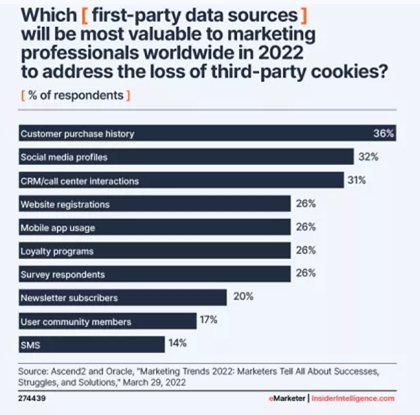The digital advertising landscape is undergoing a seismic shift. With privacy concerns and regulatory changes on the rise, the era of third-party cookies is gradually coming to an end.
In this evolving environment, understanding and adapting to cookieless advertising is important for marketers and advertisers. However, according to a 2023 Adobe study, 75% of marketers still relied heavily on third-party cookies. Additionally, over three-quarters expect the end of third-party cookies will hurt their businesses.
What Are Third-Party Cookies?
Third-party cookies are small pieces of data stored on a user’s web browser by websites other than the one the user is currently visiting. These cookies are primarily used for tracking and collecting user behavior and preferences across different websites.
The Cookie Demise
The phasing out of cookies in major web browsers like Google Chrome, Apple’s Safari, and Mozilla Firefox has been a significant development in online privacy.
Apple’s Safari
In 2017, Apple introduced Intelligent Tracking Prevention (ITP), a feature in Safari that aimed to limit cross-site tracking by third-party cookies. It restricted cookie lifetimes and introduced measures to prevent tracking across websites.
Apple has continued to update ITP in subsequent Safari releases, further tightening restrictions on third-party cookies and cross-site tracking.
Mozilla Firefox
In 2019, Mozilla Firefox introduced Enhanced Tracking Protection, which automatically blocks third-party tracking cookies by default. ETP also blocks known crypto miners and fingerprinters to enhance user privacy.
Mozilla has made ongoing improvements to ETP to enhance user privacy and security, including stricter blocking of cookies and cross-site tracking.
Google Chrome
In 2020, Google announced its intention to phase out support for third-party cookies in Chrome within two years. On Jan 4, Google began phasing out third-party cookies for 1% of users to limit cross-site tracking on the web.
As part of this initiative, Google introduced the Privacy Sandbox initiative, aiming to develop privacy-preserving alternatives to third-party cookies.
4 Cookieless Targeting Solutions for 2024
1. First-Party Data: Your New Best Friend
In the absence of third-party cookies, first-party data becomes invaluable. First-party data is information collected directly from your website visitors or customers. By utilizing this data, you can build deeper relationships with your audience, personalize content, and gain insights into their behavior.
According to a survey by Ascend2 and Oracle, the fist party data sources that marketers will be turning to in the absence of cookies include:
- 36% – Customer Purchase History
- 32% – Social Media Profiles
- 31% – CRM / Call Center Interactions


2. Contextual Advertising
Contextual advertising focuses on the content surrounding an ad placement rather than the user’s browsing history. Advertisers can align their ads with relevant content, improving user engagement and targeting without relying on cookies.
This approach hinges on the idea that users are more likely to engage with ads that are contextually relevant to the content they are currently consuming. Instead of tracking users’ online behavior, contextual advertising analyzes the content of the webpage or app where the ad will be displayed.
To implement contextual advertising effectively, algorithms and natural language processing (NLP) techniques are used to scan and analyze the text, images, and overall theme of the content on a webpage or within an app. This analysis helps determine the subject matter and context of the page.
Advertisers can select specific keywords or employ semantic targeting to ensure their ads are placed alongside content that shares similar themes or topics. For instance, a sports brand might choose keywords related to sports, fitness, or outdoor activities to display their ads in sports-related articles.
3. Retail Media Networks
Retail media networks have emerged as a strong alternative to traditional cookie-based advertising methods and a way for marketers to reach shoppers showing active purchase intent.
Retail media networks are advertising platforms operated by retailers within their digital environments. These networks allow brands and advertisers to reach consumers directly while they shop online, typically on the retailer’s website or app. Retailers leverage their first-party data, shopper insights, and the contextual relevance of their platforms to offer highly targeted and personalized advertising experiences.
Integrating ads seamlessly into the shopping experience is crucial. Native advertising within search results, product listings, or related items sections can be highly effective.
Retailers can also offer advertisers the opportunity to promote their products within search results, ensuring their products are prominently displayed when relevant.
4. Identity Resolution Strategies
Identity resolution platforms aggregate data from many consumer touchpoints. They map and connect different types of identifiers associated with individual users. These identifiers can include customer IDs, email addresses, mobile device IDs, social media handles, cookies, and more.
Several companies offer identity graphs using a persistent ID. For example, LiveRamp is a prominent player in the identity resolution and data connectivity space. They offer identity graph solutions that help businesses connect and activate their data effectively for personalized marketing and advertising.
Embrace the Cookieless Future
While the transition to a cookieless advertising landscape presents challenges, it also offers opportunities for marketers to refocus on user privacy and build more meaningful connections with their audience. By prioritizing first-party data, adopting innovative technologies, and staying attuned to industry changes, advertisers can thrive in this new era of digital marketing.





